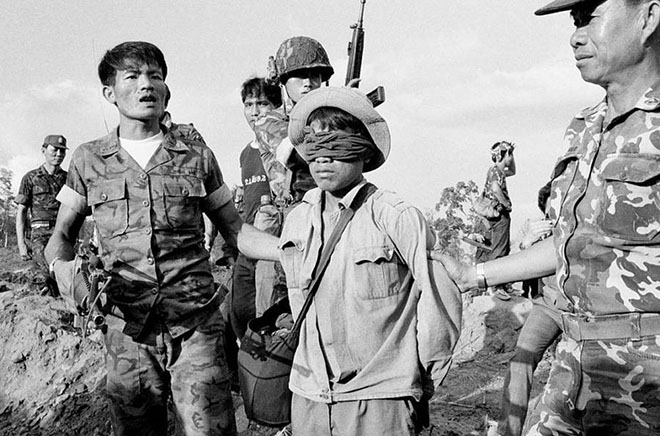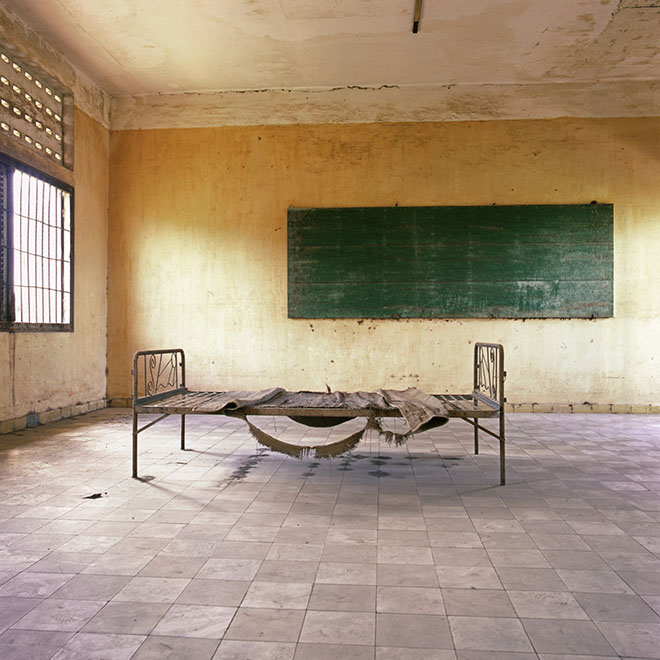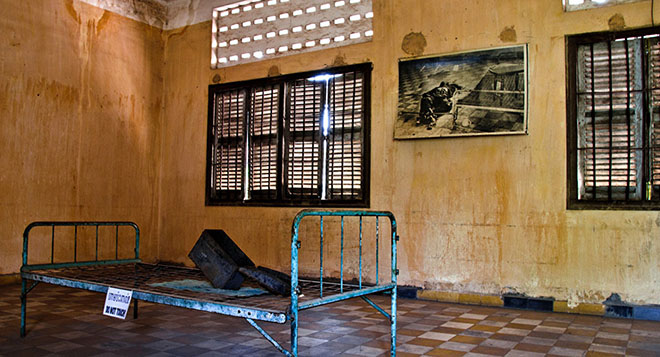Cambodia is a country full of historical attractions. Besides the world-famous Angkor Temple Complex, which marked the prosperity of an ancient dynasty, there are other places to show you a deeper part of the Cambodian. The sites that recall the darkest time in history when all the citizens suffered from vicious political dictatorship. The sites that still conceals the bones of unjustified deaths
Let’s explore Tuol Sleng Genocide Museum and Khmer Rouge Killing Fields, the bystanders of the dark part of Cambodia

2 Historic Witnesses For The Dark Past Of Cambodia
Tuol Sleng Genocide Museum
Location
The Tuol Sleng Genocide Museum was set in the capital city of Cambodia, . It chronicled the most terrible days in Cambodian history, which was the time of a massive genocide. The museum is only 10 km away from the Phnom Penh International Airport, and it takes about 10 minutes from the Royal Palace by car. It situates in such a central location even though the history of the museum is something the Cambodian want to forget.
Before transforming into a museum, it used to be a secondary school. Under the regime of Khmer Rouge, the school turned into Security Prison 21 also known as S-21 for short. The name Tuol Sleng literally means Hill of the Poisonous Trees. Although it’s just one in approximately 150 execution centers constructed by the Khmer Rouge, Tuol Sleng was supposed to retain the most significant number of prisoners and the cruelest form of torture. The figure for inmates in Tuol Sleng may far exceed 20,000 and the death toll was estimated at 18,000.
Structure Of The Museum
There are four well-preserved building entitled according to the English alphabet A, B, C and D in the Tuol Sleng Genocide Museum. Building A has large cells where the liberating force discovered the last victim. Building B is now a photograph gallery displayed black and white pictures of the prisoners who were tortured or executed. Rooms in Building C are subdivided small cells with rusting iron bed frames used to keep prisoners. The final structure, Building D, shows other memorabilia such as instruments of torture.
The Tuol Sleng Genocide Museum is open for public entrance from 8 AM to 5 PM, but the survivor testimony is only available between 2:30 and 3 PM from Monday to Friday. It is an excellent place for you to gain an in-depth insight into the Cambodian history and appreciate how strong and united its citizens have been to rejuvenate the nation.

Inside The Tuol Sleng Genocide Museum. Photo by Evgeny Nelmin
Dreadful Artifacts
What impresses most about the Tuol Sleng Genocide Museum is the instruments of torture that used to persecute prisoners. All are horrible and out of ordinary mind’s imagination.
As recorded by survivors, anyone who was taken to Tuol Sleng had to endure a process of so-called interrogation designed to make inmates admit to whatever crimes the captors charged them with. Most common types of persecution include chairs with searing hot metal instruments, electric shocks, and hanging. The captors even used plastic bags to suffocate and knives to hurt the prisoners.
For more severe charge, they could pour alcohol on the wounds, pull out fingernails and pour alcohol on the injuries, pushing the prison’s head under the water or combine the three methods to generate confession. Nowadays, visitors to Tuol Sleng still identify a lot of waterboarding tool, equipment to shackle the legs on the right bar while restraining the wrists to the left on the brackets, then pouring hot water over the face. Such a cruel act!
In some cabinets hidden behind the wall of the old school, you can see a lot of human skulls of people who died of severe torture or inadequate healthcare. There was some time when the number of the casualty was too high that the prison actually run out of burial spaces.
The Story Of The Survivors
Despite a projected number of 20,000 people to be put in jail at Tuol Sleng, only twelve were found survive after the liberating forces succeeded. There were seven adults and five children, one of whom passed away shortly after that. On hindsight, the survivors believed that they were kept alive due to their exceptional ability that the captors found useful. Some are good at drawing. Some knew how to fix equipment.
Although they were lucky to be able to survive until liberation, memories of the darkest time were still haunting them long after that. Until 2011, the Cambodian government confirmed that there were only three adults and one child to still alive. A survivor has bravely published a book to expose the cruelty of Khmer Rouge and the struggle he had to face to adapt to the normal life.

Khmer Rouge Killing Fields
Location
Accompanied by Tuol Sleng Genocide Museum, Cambodian Killing Fields are another witness for the horrible crime made by the Khmer Rouge.
The genocidal center locates a bit on the suburb of Phnom Penh, around 17 km from the Genocide Museum. From the city center, you can quickly get to both historical places on a day trip for exploration.
The most important site of the fields, Choeung Ek, is the collective burial of more than two million deaths, half of which caused by execution and the remaining were owing to starvation, disease.
What Really Happened
The Khmer Rouge lasted for only four years from 1975 to 1979, but its damage was enormous. Pol Pot and his authority detested personal possessions, establishing such unreasonable laws to divide the country, break the family ties and allure naive people into believing in peace from “purifying” harmful elements in the society.
Those who opposed to Pol Pot’s policy were confined in Tuol Sleng and many other prisons for torturing. Many others that were considered “incurable” were sent to Choeung Ek for “re-education” or sentence to death.
Khmer Rouge’s soldiers didn’t give them a peaceful death. In order to save the bullets, they used spades to smashed the heads of the unlucky, burying both the dead bodies and the fainted people together. The massive execution like this has given Choeung Ek and the large graves around the name Killing Fields.
The Killing Fields As A Remembrance
After an international troop led by the Vietnamese defeated Pol Pot and Khmer Rouge government, Choeung Ek was reconstructed into a memorial site. A commemorative stupa with Buddhist architecture design was build to soothe the long gone spirits and to appease the survivors. The Cambodian hold a memorial ceremony on May 9 annually at the Killing Fields as a reminder of the darkest time in their history.
Visitors from all over the world to this site can learn about a deeper side of such a young country as Cambodia. Also, it’s an ideal way to sympathize with the local people and truly become a responsible and knowledgeable tourist.




Comments